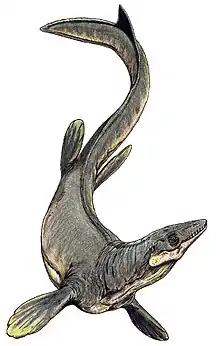| Xenodens Temporal range: Late [1] | |
|---|---|
 | |
| Holotype maxilla of Xenodens calminechari from Sidi Chennane, Morocco | |
| Scientific classification | |
| Domain: | Eukaryota |
| Kingdom: | Animalia |
| Phylum: | Chordata |
| Class: | Reptilia |
| Order: | Squamata |
| Superfamily: | †Mosasauroidea |
| Family: | †Mosasauridae |
| Subfamily: | †Mosasaurinae |
| Tribe: | †Globidensini |
| Genus: | †Xenodens Longrich et al., 2021 |
| Species: | †X. calminechari |
| Binomial name | |
| †Xenodens calminechari Longrich et al., 2021 | |
Xenodens (from Greek and Latin for "strange tooth") is an extinct genus of marine lizard belonging to the mosasaur family. It currently contains a single species, X. calminechari (From Arabic کالمنشار, meaning "like a saw"), which is known from Late Maastrichtian phosphate deposits in the Ouled Abdoun Basin, Morocco. Its closest known relative is believed to be the durophagous Carinodens.

Estimated to have measured around 1 meter (3.3 ft) in length,[2] both the genus and type species are named for the mosasaur's short and flattened blade-like teeth that collectively form a set of saw-like jaws. This is a feature that has never been seen in any other tetrapod but converge with the jaws of modern dogfish sharks and piranhas. Based on the feeding behavior of these animals, paleontologists believe that Xenodens used its highly specialized dentition for a broad diet on cephalopods, crustaceans, fish, and scavenged marine reptiles.[1]
External links
- This ancient sea reptile had a slicing bite like no other, Xenodens calminechari, with life-restoration. Science News, February 2, 2021
- Xenodens, a weird shark-toothed mosasaur from Morocco- Nick Longrich
- Dinosaur-era sea lizard had teeth like a shark
References
- 1 2 Longrich, N.R.; Bardet, N.; Schulp, A. S.; Jalil, N (2021). "Xenodens calminechari gen. et sp. nov., a bizarre mosasaurid (Mosasauridae, Squamata) with shark-like cutting teeth from the upper Maastrichtian of Morocco, North Africa" (PDF). Cretaceous Research. 123: 104764. doi:10.1016/j.cretres.2021.104764. S2CID 233567615.
- ↑ Cooper, S.L.A.; Marson, K.J.; Smith, R.E.; Martill, D. (2022). "Contrasting preservation in pycnodont fishes reveals first record of regurgitalites from the Upper Cretaceous (Maastrichtian) Moroccan phosphate deposits". Cretaceous Research. 131 (4). 105111. doi:10.1016/j.cretres.2021.105111. S2CID 244884113.
